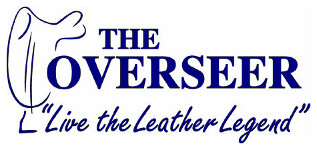Today, his Overseer sells for $4180 and Simmons supplies to a number of international riders competing in polocrosse and campdrafting.
Counterfeit saddles undermining a great Australian tradition
This article first appeared in the Australian Financial review 24th Jan 2018
When Armidale master saddler Jason Simmons was tipped off by fellow craftsmen that one of his most popular saddles, the Overseer Junior Stock Saddle, was being advertised on eBay for $769.99, less than a quarter of his price, and marketed as a "New Australian Stock Leather Saddle", he was devastated by the loss of intellectual property.
"They basically just took our photo off our website and are still using it to sell their inferior product," he says of the saddle – still available on eBay through a seller called Saddleworld, located in the northern Indian industrial city of Kanpur.
"Worst of all, it's not just poorly made, it's dangerous to the rider and harmful to the horse."
Simmons designed the Overseer model in 1996, when he opened his Overseer Saddlery business on the outskirts of Armidale, located in the vast grazing lands of the northern tablelands of NSW.
The saddle that arrived was badly made, with the seat position too high at the back, which has the effect of tipping a rider forward. The tree – the foundation of any saddle – was crooked, meaning the seat did not sit square. And the knee pads that sit above a rider's thighs, helping hold the rider in position, were unevenly steel-bolted to the tree.
"Knee pads attached in this manner pose significant risk; if the steel becomes exposed under the cheap leather, it could injure the rider," says Simmons.
"The pads also had a lot of movement in them, even though the saddle was brand new. I was shocked. It was a terrible feeling to see my work ripped off in this way. The rider will have an uncomfortable experience that is also unsafe, while the horse will sense the rider is off balance and could easily be thrown."
Patent problem
Simmons consulted an intellectual property specialist only to be told it would cost him $8000-$18,000 to register one patent or item, which would not necessarily be protected worldwide.
So he put a notification on his website and Facebook page about the breach. Within five days of being posted, the report had 10,500 views.
"A huge part of our problem is they canned the saddle makers' trade certificate in about 2007, when the horse flu hit us," says Simmons. "Now, basically anyone can produce and market a saddle in Australia. There's no official trade left."
Simmons is not alone.
There are only 30 or so true master saddlers left in Australia, making saddles by hand, which takes about 80 hours.
A factory produced machine-stitched saddle can be finished in a fraction of that time.
A number of the saddlers, mostly in NSW and Queensland, banded together late last year to lodge an official complaint with the ACCC about counterfeit saddles that copy their designs and retail far more cheaply.
The intention is to eventually launch action in the Federal Court.
"India has manufactured cheap saddles of all descriptions for centuries," says Tony Gifford, a competitive campdrafter and master saddler based in Warwick, in south-east Queensland.
"But with the popularity of e-commerce and no real copyright restrictions because most saddlers can't afford that, it's now completely out of control. And a lot of the people getting sucked in to buy these saddles are beginner riders – the people at the highest safety risk."
Gifford's custom-made CG Poley, which he sells for $4270, has been copied by two overseas manufacturers, one based in India.
Protecting an icon
Drapac is financing the saddlers' legal battle. Better known for his sponsorship of Australian cycling, Drapac is also a long-time horse enthusiast.
Now aged in his early 60s, he began making the money he used to build his Drapac Capital Partners property funds management business back in the 1970s as a bookie's pencil on the rails around Melbourne's racetracks.
Today, he has the most extensive historic collection of Australian stock saddles in the country, dating back to the 1800s when the saddle type was created by bush saddlers through trial and error.
He's in the process of creating a national museum to the dying art of traditional local saddle making, which will be located in the Macedon Ranges, about an hour's drive from Melbourne's CBD.
It's scheduled to open next year. "There are only about 20-30 people left who can make a traditional stock saddle – it's under threat," says Drapac.
"The last thing we need is cheap counterfeits confusing people and giving our national saddle a bad name," he says.
"It's a tragedy for something that should be a treasured national icon. Worst of all, these cheap copies use poor materials, particularly in stirrup leathers and girths, that break more easily during use. These cheap imitation saddles are dangerous."
While the RM Williams empire has long been known for its short riding boots, cut from a single piece of leather and sewn up the back, and Drizabone oilskins are worn from Milan to Melbourne, Australia's saddle making prowess is less acknowledged.
And yet, this saddle developed for specifically Australian weather conditions and the long distances travelled have become world famous. In his autobiography, RM Williams hailed the Australian stock saddle as "one of the finest pieces of horse furniture made and used anywhere in the world".
By comparison, he said, the American Western saddle was too heavy and wide in the seat, while the English hunting saddle wasn't sturdy enough for breaking young horses or rough riding.
Further afield, a number of celebrities, including Bruce Springsteen, have ordered stock saddles from Australian saddlers.

